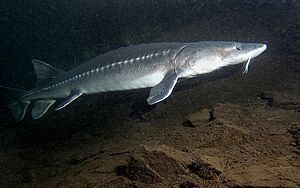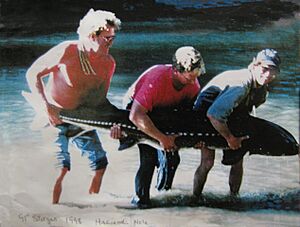White sturgeon facts for kids
Quick facts for kids White sturgeon |
|
|---|---|
 |
|
| A white sturgeon at the Oregon Department of Fish and Wildlife's Sturgeon Center at Bonneville Dam on the Columbia River. This fish is also known to be euryhaline. It’s closely related to lake sturgeon and short nose sturgeon. | |
| Conservation status | |
| Scientific classification |
The white sturgeon (Acipenser transmontanus) is a huge fish that belongs to the sturgeon family. These amazing fish are known for traveling long distances, moving from the ocean into freshwater rivers to lay their eggs. You can find them in the Eastern Pacific Ocean, all the way from Alaska down to California. Some white sturgeon even live in lakes and rivers far from the ocean, like parts of the Columbia River and Lake Shasta. They have also been seen as far south as northern Mexico.
Contents
What Does a White Sturgeon Look Like?
White sturgeon have special bony plates, called ganoid plates, on their bodies. They have two rows of these plates between their back fin and their tail. Their back fin usually has about 45 rays.
Their color can be gray or brownish on top, with a lighter belly and gray fins. They have four whisker-like feelers, called barbels, near their snout. These barbels help them find food.
How Big Do White Sturgeon Get?
When white sturgeon are old enough to reproduce, they can be about 1.6 m (5.2 ft) long. The biggest one ever recorded was an incredible 6.1 m (20 ft) long! Most adult white sturgeon are around 2.1 m (6.9 ft) long.
It's hard to know their exact age when they become adults, but they can be anywhere from 11 to 34 years old. The heaviest white sturgeon ever officially recorded weighed about 630 kg (1,390 lb). Some stories say they can weigh even more, with one fish reported to be 816 kg (1,799 lb) and 104 years old!
White Sturgeon Family Tree
White sturgeon have other common names like Pacific Sturgeon or Columbia Sturgeon. Their scientific name, Acipenser transmontanus, comes from Latin words. Acipenser means sturgeon, trans means "beyond," and montanus means "mountain."
The white sturgeon is part of a group of sturgeon species found in the Pacific Ocean. This group includes the Kaluga and Amur sturgeon, which live in Asia. Scientists have found that white sturgeon are closely related to the Amur sturgeon. They shared a common ancestor about 45.8 million years ago!
Scientists can tell white sturgeon populations apart by looking at their genes. This helps them know which river system a sturgeon comes from.
Sturgeon Chromosomes
Sturgeon species have more than two sets of chromosomes. This is called being "polyploid." It means they have extra copies of their genetic information. Scientists believe this happened during their evolution from an ancient ancestor. White sturgeon are thought to have 240 chromosomes.
Where White Sturgeon Live
White sturgeon live in many large rivers in North America that flow into the Pacific Ocean. They mostly live in estuaries, which are places where rivers meet the sea. But they travel upstream into freshwater rivers to lay their eggs. They can travel very long distances between different river systems.
You can find white sturgeon along the West Coast, from northern Mexico all the way up to Alaska. They usually prefer deep areas with soft bottoms in estuaries. Their movement in the water depends on how salty the water is.
Changes to Their Home
Over time, human activities have changed where white sturgeon live.
- Overfishing: Too many sturgeon were caught in the past.
- Dams: Dams built for power block their movement upstream. Fish ladders, which help salmon, often don't work for sturgeon.
- River Changes: Other changes to rivers also affect their homes.
These changes make it harder for sturgeon to find good places to live and move around.
Moving Around Dams
Dams in places like the Columbia River Basin have greatly changed where sturgeon can go. Sturgeon usually can't swim past dams to go upstream. They can sometimes go downstream through the dams, but it's not clear how they do it. They might go through the turbines, open gates, or special sluiceways.
What White Sturgeon Eat
When baby white sturgeon are very small, they are most likely to die when they start eating on their own. This happens about 8 to 14 days after they hatch.
Young sturgeon, called juveniles, actively search for food on the river bottom. They mostly eat small creatures like amphipods. These tiny animals are carried by the water currents to areas where the sturgeon can find them. Having enough of these small creatures is very important for the survival of young sturgeon.
Adult Sturgeon Diet
Adult white sturgeon, which are bigger than 600 mm (2.0 ft), eat many different kinds of prey. They mostly eat other fish like herring, shad, and salmon. They also eat creatures from the bottom, like clams.
White sturgeon seem to be more active at night when they are looking for food. This suggests they might be nocturnal hunters.
White Sturgeon Reproduction and Life Cycle
White sturgeon lay eggs many times throughout their lives. In some rivers, like the Sacramento and San Joaquin Rivers, they lay eggs from mid-February to late May. The busiest time for laying eggs is usually March and April.
It's a bit tricky to know exactly when white sturgeon reproduce. Different studies show different ages for when they become adults. Some studies found female sturgeon ready to lay eggs at about 9 years old. Males might be ready as young as six years old. Other reports suggest they become adults later, around 12 years for females and 10 for males.
Spawning Habits
Female white sturgeon usually lay eggs every 2 to 4 years. Males can lay eggs more often, every 1 to 2 years. When they are ready to lay eggs, many males fertilize the eggs from one female. This is called "communal broadcast spawning."
White sturgeon choose different places to lay their eggs depending on the river. They often pick areas with gravel or rocky bottoms where the water moves at a moderate to fast speed. They lay eggs in water that is 3–23 m (9.8–75.5 ft) deep.
When the female releases her eggs, they sink to the bottom. They become sticky when they touch water, which helps them attach to rocks or other things on the riverbed. The time it takes for the eggs to hatch depends on the water temperature. It can take anywhere from 3 to 13 days. The best temperature for hatching is between 14 and 16 °C (57 and 61 °F). If the water is too cold (below 8 °C (46 °F)) or too warm (above 2 °C (36 °F)), the eggs might not survive.
Why White Sturgeon Are Important
White sturgeon are important to many people around the world.
- Farms: Some farms raise white sturgeon, especially in California. Young sturgeon can even be sold to people who have large aquariums.
- Food Source: Long ago, in the 1800s, white sturgeon were a main food source for Native Americans.
- Caviar: Later, too many sturgeon were caught by fishing boats for their eggs, called caviar. This nearly made them disappear by the early 1900s.
- Other Products: Besides their meat and caviar, other valuable products from sturgeon include a substance called isinglass and oil.
It is against the law to sell wild white sturgeon or their eggs in California. However, you can legally buy caviar from white sturgeon raised on farms in California. Sadly, illegal fishing, called poaching, is still a problem. Caviar from poached sturgeon can be sold for a lot of money on the black market.
Sport Fishing
White sturgeon are also popular for sport fishing in the Pacific Northwest. In some areas, like the Columbia River Basin, you can't keep the sturgeon you catch. But "catch and release" fishing is allowed. This type of fishing is so popular that there are even special fishing trips where guides help people try to catch white sturgeon.
Protecting White Sturgeon
Scientists have been watching white sturgeon numbers in California for many years. The data shows that the number of young sturgeon joining the population can change a lot. Sometimes, there are five or more years with very few new sturgeon. This might happen because of low water levels in winter or spring.
Even though some white sturgeon populations have decreased, others in California are doing better. This has led to new fishing rules, more monitoring, research, and efforts to help sturgeon move past dams and restore their homes.
Current Status
White sturgeon populations are generally strong, with tens of thousands of young and adult fish. However, managing them is tricky because they face challenges like:
- Pollution: Chemicals in the water can harm them.
- Habitat Changes: Rivers and estuaries are being changed by human activities.
- Fishing: Even with rules, fishing can still impact them.
- Long Lifespan: Because they live a long time, it can be hard to see problems with their reproduction right away.
NatureServe, an organization that tracks species, says white sturgeon are globally secure. But in California, they are considered "imperiled" (at risk) because of human impacts on their homes. The American Fisheries Society thinks they are Endangered. Also, an international agreement called CITES lists white sturgeon in Appendix II. This means that while they are not directly threatened with extinction, their trade must be controlled to make sure they survive.






